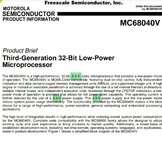croissantking
Well-known member
Ooh this looks like a fun project for my 540c. How difficult was it to source and swap over the chips? Did anything cause any problems during the process?
To source? Very difficult –
I found one on eBay after a lot of digging and persistence.
There are some reconditioned 68040FE33V chips on eBay and AliExpress, but 100% avoid those because even the non-fakes don't have an FPU according to Motorola's spec sheet. My chip ending in M is the same as the ones seen in the PowerBook 550c.
To swap over? It depends –
It's not a job for a beginner in SMD rework. For an experienced person, it's relatively easy to do, you just have to take a lot of care not to bend the pins while removing and cleaning up the donor chip. On the CPU card that's being reused, you also have to take great care to clean up the pads without lifting any.
On my first attempt, the CPU card worked, but then froze up after 5 minutes of runtime, and then it wouldn't reboot. I reflowed all the pins and it still didn't work, so I went back again and identified a couple of solder bridges. After cleaning those up, it now runs reliably. A microscope would have helped a lot – it's my next purchase.
Last edited:

